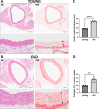Functional deterioration of vascular mitochondrial and glycolytic capacity in the aortic rings of aged mice
- PMID: 38418756
- PMCID: PMC11226416
- DOI: 10.1007/s11357-024-01091-6
Functional deterioration of vascular mitochondrial and glycolytic capacity in the aortic rings of aged mice
Abstract
Vascular ageing is associated with increased arterial stiffness and cardiovascular mortality that might be linked to altered vascular energy metabolism. The aim of this study was to establish a Seahorse XFe96 Analyzer-based methodology for the reliable, functional assessment of mitochondrial respiration and glycolysis in single murine aortic rings and to validate this functional assay by characterising alterations in vascular energy metabolism in aged mice. Healthy young and old C57BL/6 mice were used for the analyses. An optimised setup consisting of the Seahorse XFe96 Analyzer and Seahorse Spheroid Microplates was applied for the mitochondrial stress test and the glycolysis stress test on the isolated murine aortic rings, supplemented with analysis of NAD content in the aorta. To confirm the age-dependent stiffness of the vasculature, pulse wave velocity was measured in vivo. In addition, the activity of vascular nitric oxide synthase and vascular wall morphology were analysed ex vivo. The vascular ageing phenotype in old mice was confirmed by increased aortic stiffness, vascular wall remodelling, and nitric oxide synthase activity impairment. The rings of the aorta taken from old mice showed changes in vascular energy metabolism, including impaired spare respiratory capacity, maximal respiration, glycolysis, and glycolytic capacity, as well as a fall in the NAD pool. In conclusion, optimised Seahorse XFe96-based analysis to study energy metabolism in single aortic rings of murine aorta revealed a robust impairment of functional vascular respiratory and glycolytic capacity in old mice linked to NAD deficiency that coincided with age-related aortic wall remodelling and stiffness.
Keywords: Ageing; Aorta; Glycolysis; Mitochondrial function; NAD; Seahorse XF technique; Vascular stiffness.
© 2024. The Author(s).
Conflict of interest statement
The authors declare no competing interests.
Figures






References
Publication types
MeSH terms
Grants and funding
LinkOut - more resources
Full Text Sources
Medical

